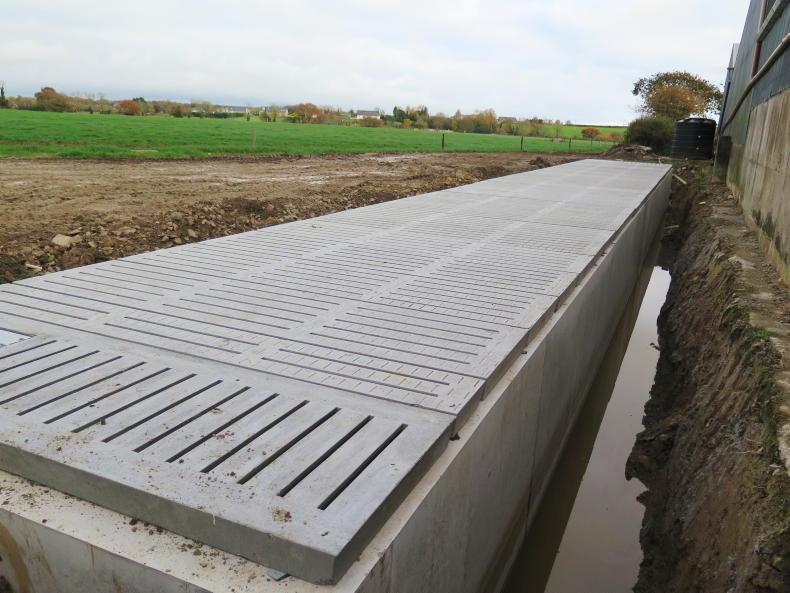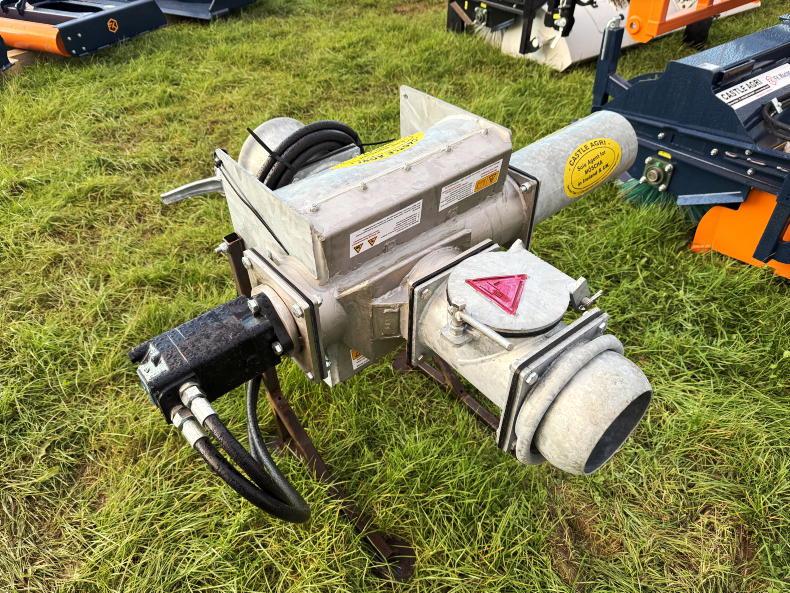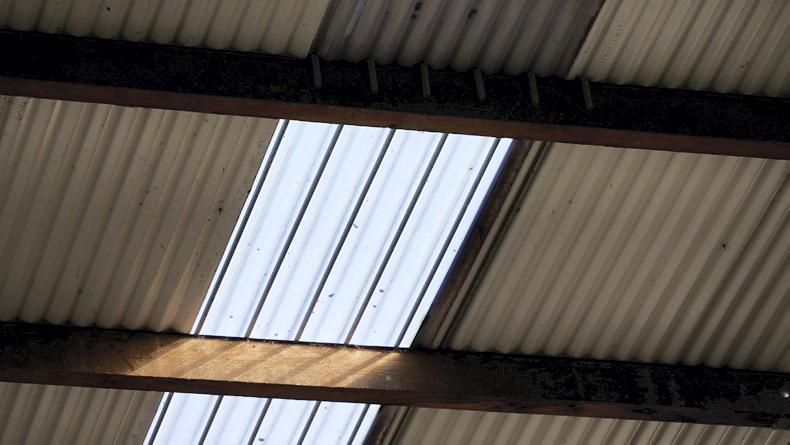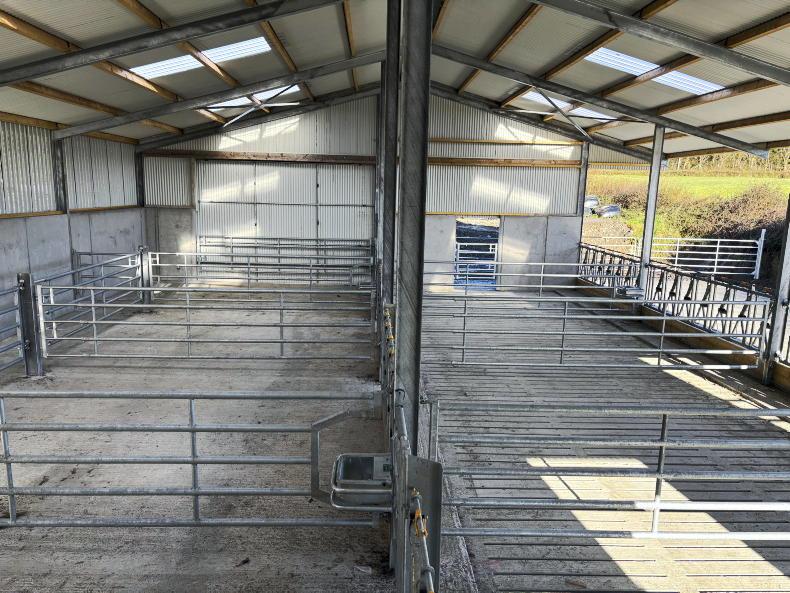Slurry storage seems to be taking more and more of a focus every year. This year, farmers who took the opportunity that a dry late January and February gave to empty tanks were in luck, as the weather broke after this and halted tankers and umbilical systems.
I’m often asked as to where value lies when it comes to slurry storage. As a general rule of thumb, the standard concrete tank will work out cheaper for small to medium volumes, as well as having the benefit of using it as a cow area.
In the below case study, I take a typical farmer who wishes to increase storage on what would be a common dairy farm size.
As part of new nitrates rules that came into effect in March 2022, all slurries produced on farms must be applied before 1 October 2023, and up to 15 October where special criteria are met. This will include weather conditions, grass growth, and the individual situation on farms.
Where this criteria are met, farmers may be eligible to spread slurry up to 15 October of that year, although no guarantee is given as to the availability of this option.
This is two weeks shorter than what farmers are accustomed to, and while it generally won’t affect farmers in normal weather conditions, where it could prove difficult is when stock are housed in late September/October during a wet autumn.
Soiled water storage requirements have also increased.
From January this year, all milk producers must have a minimum three weeks’ soiled water storage, with the closed period for spreading soiled water being 10 December to 31 December 2023.
This requirement will increase to four weeks’ storage for creamery milk suppliers in 2024, while those on liquid milk contracts have up until 2025 to secure four weeks’ soiled water storage.
Soiled water includes water from concreted areas, hard-standing areas, holding areas for livestock and other farmyard areas where such water is contaminated by contact with livestock faeces, urine, or silage effluent; chemical fertilisers; washing such as vegetable washing or milking parlour washing; and water used in washing farm equipment.
The main enterprises that this rule will affect are dairy farmers (milking parlour washings) and those in the production of root vegetables (washings created from cleaning in food preparation).
Recommendation
To calculate soiled water storage requirements for dairy farms, Teagasc recommends that farmers allocate 30 litres/cow/day. To satisfy the upcoming four-week storage requirement, farmers will need 1.26m3 (227 gallons) of storage per cow.
Case study
Margaret is a young trained farmer milking 120 cows on a creamery contract in Limerick. All slurry storage is under cover, so no rainwater is mixing with the slurry. Thirty weanling heifers are kept each year as well as the 120 cows/in-calf heifers.
Margaret milks through an eight-unit herringbone parlour, with the plan being to increase this to a 20-unit parlour through using the TAMS III Dairy Equipment Scheme (DES), while also increasing cow numbers to 140.
There are three things to note in the above.
Firstly, the farm intends to increase cow numbers by 20, which will require additional slurry storage itself.
Increase milking units
Margaret also intends applying for the TAMS III DES to increase the milking units in their parlour, which will require her to have an additional 10% extra storage above the requirement.
As well as this, the farm intends to use an existing slatted tank to function for soiled water storage, due to the increased storage requirements and the increased parlour and herd size.
Taking all this into account, Margaret will require 739.2m3 storage for the 140 cows and an additional 72m3 for the 30 weanling heifers for a 16-week winter.
However, the farm will require 10% over and above the minimum requirement as Margaret is applying for additional clusters through TAMS DES.

Larger slurry stores may present better value for money, although a reception tank and cover may have to be installed.
In total, she will require 892.32m3 of net slurry storage. After calculating all usable slurry storage, Margaret requires 200m3 extra storage.
The two most obvious options here for Margaret are a mass concrete tank (slatted tank) or an overhead slurry store.
The economics of constructing concrete slatted tanks are to create the tank as wide and as deep as possible. For the purpose of this case study, I’ve left the tank at 2.4m depth (8ft) with a 14ft 6in slat over the tank.
Internal measurements are as follows: 22.2m long, 2.4m deep and 4.72m wide. This creates 215m3 of usable storage (200m freeboard deducted).
Extending the tank to 22.2m allows for a standard four-bay shed (19.2m long) to be built over the tank with an external agitation point at either end. The reference cost for the above tank with TAMS III is €23,384.79.
For a circular slurry tower of similar capacity, the TAMS reference cost would be €33,427.05. This excludes taking into account a required 200mm of freeboard if the tank is covered, with 300mm required if it remains uncovered. If the tank remains uncovered, rainfall will have to be taken into account and subtracted from the storage capacity of the overhead tank.
The overhead slurry store will also require a concrete reception tank, as well as pumping from the reception tank to the slurry store.
What should she go for?
Based on cost alone, Margaret should opt for the concrete slatted tank and to build a cubicle shed over it. A double row of cubicles could easily be constructed to accommodate the extra 20 cows she is planning on.
Of course, this will lead to further spending, but it is likely that Margaret requires the additional cubicles anyway. The reference cost for the above tank is €23,384.79.
Margaret will be able to claim €14,030 back in grant aid (young trained farmer at 60% grant rate) on the reference cost. In my experience, actual costs are about 20% higher than the given reference costs, so the above tank is likely to cost €28,061, resulting in a net cost (less grant aid) of €14,031 to Margaret.
As is often the case, the overhead slurry tower at this required volume works out more expensive on an m³ basis.
Where slurry stores work best is where a large volume of storage is required, or where flow channels directed towards slurry stores are in place. Overhead towers also have the ability for their capacity to be increased in the future by the addition of another ring if needed.
Margaret in the case study here is what the Department of Agriculture would classify as your ‘average’ dairy farmer with the amount of stock she has.
Even with the additional 10% extra storage required for the TAMS DES, she is increasing her storage by close to 30% for €14,000.
With recent comments from Minister McConalogue fixing his gaze on the ‘slurry bandits’, a longer closed period for spreading soiled water and with increased pressure on our social licence to farm and public perception, it is a small cost to bear.
Slurry storage seems to be taking more and more of a focus every year. This year, farmers who took the opportunity that a dry late January and February gave to empty tanks were in luck, as the weather broke after this and halted tankers and umbilical systems.
I’m often asked as to where value lies when it comes to slurry storage. As a general rule of thumb, the standard concrete tank will work out cheaper for small to medium volumes, as well as having the benefit of using it as a cow area.
In the below case study, I take a typical farmer who wishes to increase storage on what would be a common dairy farm size.
As part of new nitrates rules that came into effect in March 2022, all slurries produced on farms must be applied before 1 October 2023, and up to 15 October where special criteria are met. This will include weather conditions, grass growth, and the individual situation on farms.
Where this criteria are met, farmers may be eligible to spread slurry up to 15 October of that year, although no guarantee is given as to the availability of this option.
This is two weeks shorter than what farmers are accustomed to, and while it generally won’t affect farmers in normal weather conditions, where it could prove difficult is when stock are housed in late September/October during a wet autumn.
Soiled water storage requirements have also increased.
From January this year, all milk producers must have a minimum three weeks’ soiled water storage, with the closed period for spreading soiled water being 10 December to 31 December 2023.
This requirement will increase to four weeks’ storage for creamery milk suppliers in 2024, while those on liquid milk contracts have up until 2025 to secure four weeks’ soiled water storage.
Soiled water includes water from concreted areas, hard-standing areas, holding areas for livestock and other farmyard areas where such water is contaminated by contact with livestock faeces, urine, or silage effluent; chemical fertilisers; washing such as vegetable washing or milking parlour washing; and water used in washing farm equipment.
The main enterprises that this rule will affect are dairy farmers (milking parlour washings) and those in the production of root vegetables (washings created from cleaning in food preparation).
Recommendation
To calculate soiled water storage requirements for dairy farms, Teagasc recommends that farmers allocate 30 litres/cow/day. To satisfy the upcoming four-week storage requirement, farmers will need 1.26m3 (227 gallons) of storage per cow.
Case study
Margaret is a young trained farmer milking 120 cows on a creamery contract in Limerick. All slurry storage is under cover, so no rainwater is mixing with the slurry. Thirty weanling heifers are kept each year as well as the 120 cows/in-calf heifers.
Margaret milks through an eight-unit herringbone parlour, with the plan being to increase this to a 20-unit parlour through using the TAMS III Dairy Equipment Scheme (DES), while also increasing cow numbers to 140.
There are three things to note in the above.
Firstly, the farm intends to increase cow numbers by 20, which will require additional slurry storage itself.
Increase milking units
Margaret also intends applying for the TAMS III DES to increase the milking units in their parlour, which will require her to have an additional 10% extra storage above the requirement.
As well as this, the farm intends to use an existing slatted tank to function for soiled water storage, due to the increased storage requirements and the increased parlour and herd size.
Taking all this into account, Margaret will require 739.2m3 storage for the 140 cows and an additional 72m3 for the 30 weanling heifers for a 16-week winter.
However, the farm will require 10% over and above the minimum requirement as Margaret is applying for additional clusters through TAMS DES.

Larger slurry stores may present better value for money, although a reception tank and cover may have to be installed.
In total, she will require 892.32m3 of net slurry storage. After calculating all usable slurry storage, Margaret requires 200m3 extra storage.
The two most obvious options here for Margaret are a mass concrete tank (slatted tank) or an overhead slurry store.
The economics of constructing concrete slatted tanks are to create the tank as wide and as deep as possible. For the purpose of this case study, I’ve left the tank at 2.4m depth (8ft) with a 14ft 6in slat over the tank.
Internal measurements are as follows: 22.2m long, 2.4m deep and 4.72m wide. This creates 215m3 of usable storage (200m freeboard deducted).
Extending the tank to 22.2m allows for a standard four-bay shed (19.2m long) to be built over the tank with an external agitation point at either end. The reference cost for the above tank with TAMS III is €23,384.79.
For a circular slurry tower of similar capacity, the TAMS reference cost would be €33,427.05. This excludes taking into account a required 200mm of freeboard if the tank is covered, with 300mm required if it remains uncovered. If the tank remains uncovered, rainfall will have to be taken into account and subtracted from the storage capacity of the overhead tank.
The overhead slurry store will also require a concrete reception tank, as well as pumping from the reception tank to the slurry store.
What should she go for?
Based on cost alone, Margaret should opt for the concrete slatted tank and to build a cubicle shed over it. A double row of cubicles could easily be constructed to accommodate the extra 20 cows she is planning on.
Of course, this will lead to further spending, but it is likely that Margaret requires the additional cubicles anyway. The reference cost for the above tank is €23,384.79.
Margaret will be able to claim €14,030 back in grant aid (young trained farmer at 60% grant rate) on the reference cost. In my experience, actual costs are about 20% higher than the given reference costs, so the above tank is likely to cost €28,061, resulting in a net cost (less grant aid) of €14,031 to Margaret.
As is often the case, the overhead slurry tower at this required volume works out more expensive on an m³ basis.
Where slurry stores work best is where a large volume of storage is required, or where flow channels directed towards slurry stores are in place. Overhead towers also have the ability for their capacity to be increased in the future by the addition of another ring if needed.
Margaret in the case study here is what the Department of Agriculture would classify as your ‘average’ dairy farmer with the amount of stock she has.
Even with the additional 10% extra storage required for the TAMS DES, she is increasing her storage by close to 30% for €14,000.
With recent comments from Minister McConalogue fixing his gaze on the ‘slurry bandits’, a longer closed period for spreading soiled water and with increased pressure on our social licence to farm and public perception, it is a small cost to bear.










SHARING OPTIONS